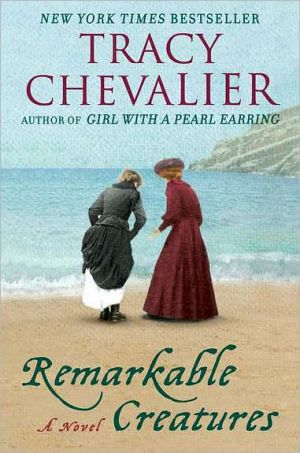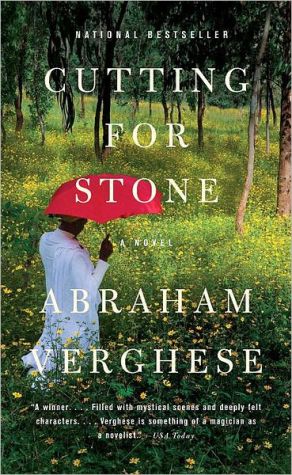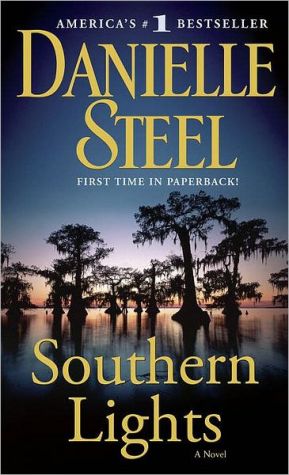Remarkable Creatures
"From the moment she's struck by lightning as a baby, it is clear Mary Anning is different. Though poor and uneducated, she discovers on the windswept beaches of the English coast that she has a unique gift: "the eye" to spot fossils no one else can see. When Mary uncovers an unusual fossilized skeleton in the cliffs near her home, she sets the religious fathers on edge, the townspeople to gossip - and the scientific world alight. In an arena dominated by men, however, Mary is barred from the...
Search in google:
A voyage of discoveries, a meeting of two remarkable women, and extraordinary time and place enrich bestselling author Tracy Chevalier's enthralling new novelFrom the moment she's struck by lightening as a baby, it is clear that Mary Anning is marked for greatness. On the windswept, fossil-strewn beaches of the English coast, she learns that she has "the eye"-and finds what no one else can see. When Mary uncovers an unusual fossilized skeleton in the cliffs near her home, she sets the religious fathers on edge, the townspeople to vicious gossip, and the scientific world alight. In an arena dominated by men, however, Mary is barred from the academic community; as a young woman with unusual interests she is suspected of sinful behavior. Nature is a threat, throwing bitter, cold storms and landslips at her. And when she falls in love, it is with an impossible man.Luckily, Mary finds an unlikely champion in prickly Elizabeth Philpot, a recent exile from London, who also loves...Publishers WeeklyThe discoveries of fossils on the beaches of Lyme Regis, England, in the 19th century rocked the world and opened the minds of scientists to the planet's unimaginable age and the extinction of species. Though attributed to men of consequence, the first remarkable finds were made by the poor working-class Anning family—and their young daughter, Mary. Chevalier wraps the history with a tale of the friendship between Mary and Elizabeth Philpot, a gentlewoman also fascinated by the creatures of stone, in a time when women were thought to be ill-suited to the work or incapable of understanding the scope of their finds. Each of these two characters tells a first-person story, and Susan Lyons gives Elizabeth Philpot the diction, reserve, subdued tones, and poise expected of a gentlewoman and shades her with idiosyncrasies, passions, and palpable loneliness. Charlotte Parry is convincing as a callow, coarse Mary Anning, and listeners will witness her gradual maturing and refinement as the story unfolds. The quality audio production enhances Chevalier's picturesque historical novel. A Dutton hardcover (Reviews, Sept. 28). (Jan.)
\ Publishers WeeklyThe discoveries of fossils on the beaches of Lyme Regis, England, in the 19th century rocked the world and opened the minds of scientists to the planet's unimaginable age and the extinction of species. Though attributed to men of consequence, the first remarkable finds were made by the poor working-class Anning family—and their young daughter, Mary. Chevalier wraps the history with a tale of the friendship between Mary and Elizabeth Philpot, a gentlewoman also fascinated by the creatures of stone, in a time when women were thought to be ill-suited to the work or incapable of understanding the scope of their finds. Each of these two characters tells a first-person story, and Susan Lyons gives Elizabeth Philpot the diction, reserve, subdued tones, and poise expected of a gentlewoman and shades her with idiosyncrasies, passions, and palpable loneliness. Charlotte Parry is convincing as a callow, coarse Mary Anning, and listeners will witness her gradual maturing and refinement as the story unfolds. The quality audio production enhances Chevalier's picturesque historical novel. A Dutton hardcover (Reviews, Sept. 28). (Jan.)\ \ \ \ \ Library JournalIn early 1800s England, unmarried women of the upper classes were often relegated to the fringes of society, where they could find a polite way to spend their days; those of the lower classes had even fewer options. This work, based on a true story, portrays two women from these diverse backgrounds who share a fascination with fossils. Mary Anning is an impoverished girl with a gift for finding prehistoric skeletons along the coast, which also interest genteel spinster Elizabeth Philpot. She recognizes Mary's talent as she also understands the enormous implications of the specimens uncovered, for this was before Darwin, when the concept of extinction was unknown, and it was blasphemous to consider that some of God's creatures may have been flawed. Over time, both women strive for scientific credibility, love, and financial stability, with varying degrees of success. VERDICT Superbly creating a unique setting, as she did in The Girl with a Pearl Earring, Chevalier captures the atmosphere of a chilly, blustery coast and an oppressive social hierarchy in real Dickensian fashion. Readers of historical fiction will enjoy this fascinating tale of rustic paleontology. [See Prepub Alert, LJ 9/1/09.]—Susanne Wells, P.L. of Cincinnati & Hamilton Cty.\\\ \ \ Kirkus ReviewsMore fact-based historical fiction from Chevalier (Burning Bright, 2007, etc.): the vivid, rewarding tale of 19th-century fossil hunter Mary Anning. Before Darwin's findings rocked the world, a small group of scientists were already-in some people's view, blasphemously-questioning the age of the Earth, the finality of God's creation and the possibility of an ancient world before man. In young Mary's case, however, finding fossils quite simply keeps her family from the workhouse. Raised in Lyme Regis on the English coast, she's trained by her father to spot what they call "curies" (curiosities): ammonites, belemnites, fossilized fish on the beach and embedded in cliffs that the family sells to tourists during the summer. Paired with Mary's narrative is that of Elizabeth Philpot, dispatched with her two sisters from London to the coast when their brother marries. Elizabeth (also a historical figure, like most of the characters) is impressed by Mary's sharp eye and considerable knowledge about fossils, remarkable qualities for an illiterate girl. Plain, outspoken and without the substantial income that would make those failings palatable, Elizabeth is resigned to spinsterhood, but Lyme offers outlets for her curiosity about the natural world, as well as the satisfaction of watching a burgeoning science develop. She forms an unlikely alliance with Mary as they comb the beach together, and when Mary's discoveries of several complete dinosaur fossils (including a pterodactyl) bring the scientific community to her door, Elizabeth acts as spokeswoman for her less confident friend. Chevalier handles the science with a deft hand, but her real subject is two women barred from the professionalcommunity of men who are also denied access to the more acceptable roles of wife and mother. (Mary's "unwholesome" pursuits and working-class background put her beyond the pale of proper society.). Yet somehow Mary and Elizabeth thrive, and the novel glories in their substantial achievements against considerable odds. Shines a light on women usually excluded from history-and on the simple pleasures of friendship.\ \ \ \ \ Publishers WeeklyThe discoveries of fossils on the beaches of Lyme Regis, England, in the 19th century rocked the world and opened the minds of scientists to the planet's unimaginable age and the extinction of species. Though attributed to men of consequence, the first remarkable finds were made by the poor working-class Anning family—and their young daughter, Mary. Chevalier wraps the history with a tale of the friendship between Mary and Elizabeth Philpot, a gentlewoman also fascinated by the creatures of stone, in a time when women were thought to be ill-suited to the work or incapable of understanding the scope of their finds. Each of these two characters tells a first-person story, and Susan Lyons gives Elizabeth Philpot the diction, reserve, subdued tones, and poise expected of a gentlewoman and shades her with idiosyncrasies, passions, and palpable loneliness. Charlotte Parry is convincing as a callow, coarse Mary Anning, and listeners will witness her gradual maturing and refinement as the story unfolds. The quality audio production enhances Chevalier's picturesque historical novel. A Dutton hardcover (Reviews, Sept. 28). (Jan.)\ \ \ \ \ Library JournalNew York Times best-selling author Chevalier's (www.tchevalier.com) sixth historical novel, following Burning Bright (2007)—also available from Recorded Books and Penguin Audio—centers on two unique women who bond over their shared love of fossils. Chevalier's overemphasis on the gender inequalities and class rivalries of early 19th-century England occasionally weighs the novel down, but the juxtaposition of actresses Charlotte Parry's and Susan Lyons's vocal qualities as they render their respective characters provides auditory interest, and the joint narration of the text helps to move the story along. Those with a predilection for historical fiction, English settings, and strong female characters will greatly enjoy this audio, which benefits from beginning- and end-of-disc announcements. [The Dutton hc received a starred review, LJ 11/1/09.—Ed.]—David Faucheux, Louisiana Audio Information & Reading Svc., Lafayette\ \ \ \ \ The Barnes & Noble ReviewIn England two hundred years ago, when Tracy Chevalier's new novel takes place, the idea that animals could become extinct was too radical for most to contemplate. Fossils could be decorative and might even have magical powers, but they couldn't possibly be the remains of creatures that God had erased from the world. Surely, people thought, the huge, toothy skeletons that were beginning to be unearthed from the cliffs of Lyme Regis, a shabby resort town on the Dorset coast, must belong to beasts that still exist in some remote land.\ Imagine the anxiety these beliefs produced. What if one of those bloodthirsty monsters suddenly swam up onto the beach? What if the Earth (which, according to church doctrine, was created by God in six 24-hour time slots beginning at 8:00 PM on October 23, 4004 BC) was in fact always changing, and not comfortingly constant? For conventional Britons of the Regency period, the discovery of these fossils was amazing and disturbing in equal measure.\ Such a milieu offers rich reserves for a historical novelist to plumb. And Chevalier's story -- whose outlines are mostly true, though the author admits in a postscript that she "made up plenty" -- gets even better as she explains who was performing those early-nineteenth-century Lyme Regis excavations.\ It was a working-class girl named Mary Anning, who kept her family out of the poorhouse by selling "curies" -- curiosities -- that she found on the beach. (She inspired the tongue-twister "She sells seashells by the seashore.") Mary Anning had very little education and few rights -- no women of any class could vote or attend university at the time, and certainly none wouldbe allowed across the threshold of London's Geological Society, where Anning's finds were hotly discussed -- yet she knew more about the fledgling field of paleontology than all the blustery gentlemen collectors who charged onto the Lyme beaches, hoping to nab themselves a specimen.\ In 1810, at age eleven, Mary uncovered the first complete skeleton of an ichthyosaurus, though it then had no name and was thought to be some sort of crocodile. (The word "dinosaur" would not enter the language until 1824.) In 1821 she found the first plesiosaurus, and in 1828 the first dimorphodon, a kind of pterosaur. These major discoveries brought her fame during her lifetime, but never distinction, or even financial solvency. She remained, as one of Chevalier's male characters describes her, "a spare part," an oddball, an outsider.\ "The world has used me so unkindly, I fear it has made me suspicious of every one," Mary once wrote in a letter. Yet Chevalier is much too canny a novelist to turn her version of Anning's life into a strident catalogue of feminist and class-discrimination grievances. Instead, in Chevalier's imagining, Mary's grim limitations cling to her as plainly and stubbornly as her ambitions, without much fuss. This is a quiet book, it turns out, about a spinster who walked up and down the beach nearly every day of her life. Like Chevalier's most popular previous novel, Girl with a Pearl Earring, its eloquence lives in that quietness, its frankness like cold clear water after too much wine.\ Mary's voice alternates throughout Remarkable Creatures with that of her friend Elizabeth Philpot, another unmarried woman, twenty years her senior. Elizabeth lives with her sisters in Lyme's more upscale neighborhood, sustained by a secure but hardly lavish annuity. More or less resigned to spinsterhood ("too plain, and too serious") and in need of something to occupy herself, Elizabeth cultivates an interest in fossil fish, becoming nearly as accomplished as Mary in finding specimens. Although they become rivals for the scant attentions of at least one unsuitable suitor, and despite their differences in age, class, and education, Mary and Elizabeth develop a long, useful friendship. (Like Anning, Elizabeth Philpot was a real person who made important contributions to fossil science; the Philpot Museum in Lyme Regis, quite active today, was built on the site of Mary Anning's birthplace.)\ It's Elizabeth, in Chevalier's dramatization, who encourages Mary to learn to read, and teaches her to label her fossils using Linnaean classification instead of Anning's childish diminutives, her "ammos and bellies and lilies and gryphies." She advances money to Mary to help pay for excavations, and once even pulls the younger woman out of a landslip that has buried her in an ooze of blue clay, a common enough danger on Lyme's ever-shifting cliffs.\ For her part, Mary teaches Elizabeth how to hone her vision when fossil hunting, and then how to clean and display her treasures. Perhaps more important, the two friends find companionship in a society that only recognizes women in service to men, and thus views these spinsters as suspiciously peculiar. The rescue of a happy marriage, like those in the novels by Jane Austen which Elizabeth's sister Margaret favors, is less and less likely as the years pass. So they stave off loneliness in the silent amity of long beachcombing days.\ "A woman's life is always a compromise," Elizabeth muses with some bitterness. Meanwhile, buzzing around Mary is a throng of wealthy, unimpeded men, eager to use her as "a knowledgeable servant" to advance their own dreams of scientific glory. Free to be as eccentric as they please without fear of ostracism, these figures (again, almost all of them real) would receive star billing in The Big Book of British Weirdos, if such a book existed (and I so wish it did). Among their number are William Buckland, the flamboyant Oxford geologist whose hobbies include eating one of every species in the animal kingdom, and retired blowhard Colonel Thomas Birch, who in his fossil-collecting fervor treats Mary with both surprising kindness and heedless cruelty.\ Amid all this clamor, two women are quietly making discoveries that will change the way men understand the world, opening the way to Darwin and the battles over creation that continue in our own day. Chevalier gets everything right here -- the din and the silence, the strangeness of those times and the shadowing of our own -- and then, with practical effectiveness, she wisely gets out of the way. --Donna Rifkind\ \ \







